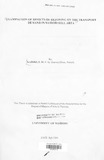| dc.description.abstract | The Hill Area which is adjacent the CBD was a low-density residential area. Since the
late 1960's when the Ministry of Works building was constructed within the
Community Building area, was the only office development at the time. But from
about the 1980's the character of the area has been changing rapidly from low-density
residential development to high-rise office blocks. Such development however, had
been taking place on the basis of the inadequate existing surveyed plots whose use was
residential. Other than that, there had not been adequate guidelines for the
development of the area. This pressured the Nairobi City Council Planning
Department to form a liaison committee to look into the possibilities of re-zoning the
area in order to harmonize development of the area. The committee findings rubberstamped
the change of user from residential to include commercial, office blocks and
high-rise flats. The zoning plan was commissioned but for one thing, the plan had not
dealt with the issue of transportation. It was in this light that the research embarked on
the study to investigate the transportation demand of the area.
The study established that the area require public service vehicles for the 'community
living and working there. There is also the need for widening the road system and
providing for terminal facilities for the motorised traffic. Due to the nature of the
close proximity of the location of the area to, the CBD, there is need for providing for
facilities for the Non-Motorised Iritermediate Means of Transport alongside the
existing motorised facilities so as to avoid conflict between the two systems.
The study recommends that future rezoning should be carried out concurrently with
the transport system planning. In the situation where this is not possible, the
transportation planning should precede re-zoning. Also recommended is coordination
between the concerned government departments so that planning is overall i.e. there is
coordination between the land use planner transport planners as well traffic planner. | en |

